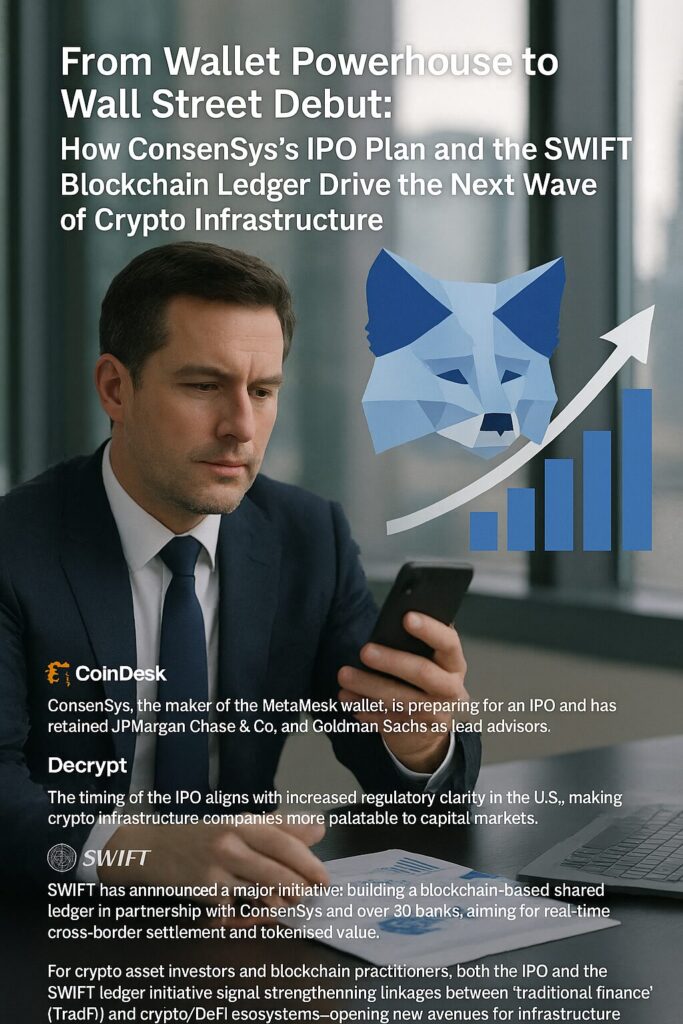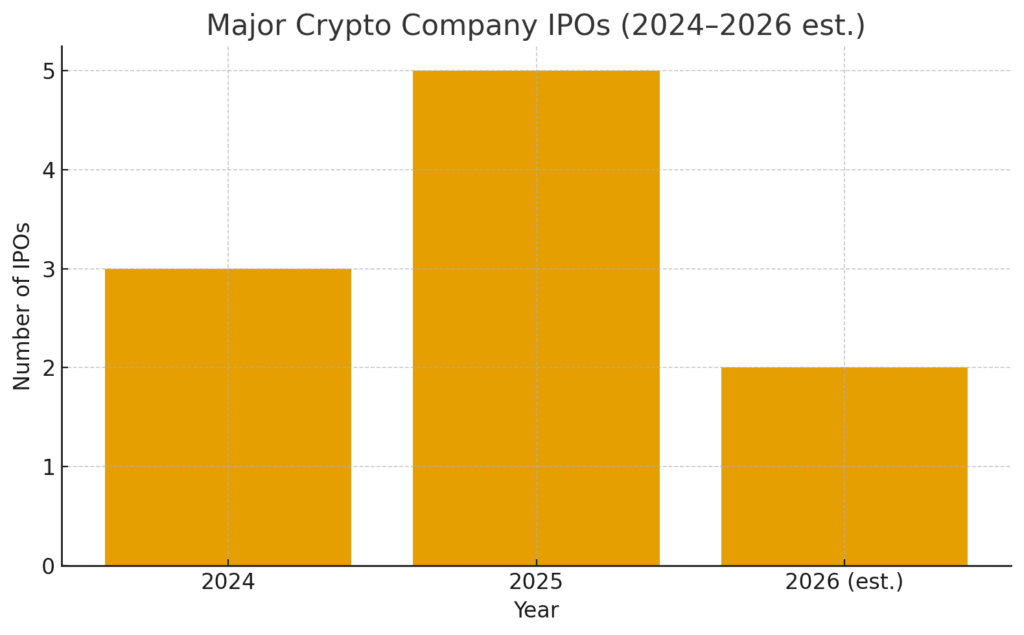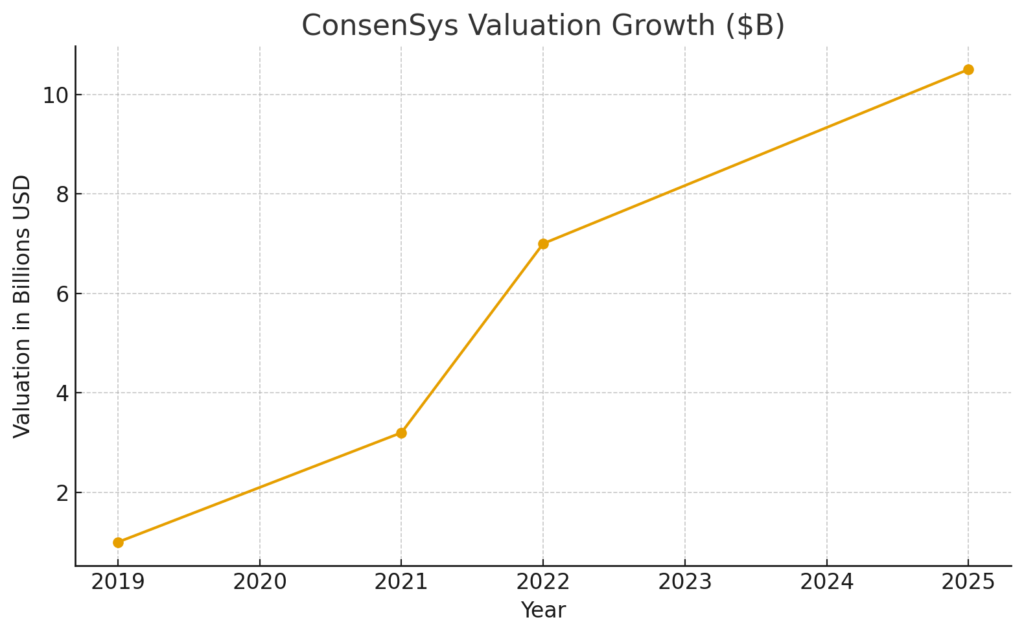
Main Points :
- ConsenSys, the maker of the MetaMask wallet, is preparing for an IPO and has retained JPMorgan Chase & Co. and Goldman Sachs as lead advisors.
- The timing of the IPO aligns with increased regulatory clarity in the U.S., making crypto infrastructure companies more palatable to capital markets.
- ConsenSys is concurrently deepening its Web3 infrastructure play (Layer 2 chains, tokenisation, DeFi) which underpins the value proposition of the IPO.
- SWIFT has announced a major initiative: building a blockchain-based shared ledger in partnership with ConsenSys and over 30 banks, aiming for real-time cross-border settlement and tokenised value.
- For crypto asset investors and blockchain practitioners, both the IPO and the SWIFT ledger initiative signal strengthening linkages between “traditional finance” (TradFi) and crypto/DeFi ecosystems—opening new avenues for infrastructure tokens, tokenised assets, and yield strategies.
- However, challenges remain: execution risk (both in IPO timing and infrastructure scaling), regulatory uncertainty (especially around token issuances and staking), and the question of how value is monetised in blockchain infrastructure.
1. ConsenSys IPO: A Milestone for Crypto Infrastructure

ConsenSys—founded by Joseph Lubin, who co-founded Ethereum—has long been a pillar of the Web3 infrastructure stack. Its best-known consumer-facing product is the MetaMask wallet, which acts as a user gateway to Ethereum-based dApps.
According to multiple reports, ConsenSys has engaged JPMorgan and Goldman Sachs to advise and possibly underwrite a public listing. The news suggests the IPO could be one of the largest by an Ethereum-native company, and would mark crypto infrastructure’s arrival on mainstream capital markets.
Why this matters

- The move signals investor confidence: crypto companies are now being evaluated like tech/fintech firms rather than speculative ventures.
- For the user base of MetaMask and Ethereum developers, a public listing by this infrastructure provider could lead to increased transparency, capital for growth, and maybe tokenisation of equity or loyalty systems.
- For the broader crypto-asset market, the listing may create an “on-ramp” for infrastructure-centric tokens—not only native assets like ETH, but tokens tied to services (wallets, node infrastructure, staking).
- Importantly, ConsenSys is not just a wallet vendor: it also accelerates Layer 2 networks (e.g., Linea), treasury management firms (e.g., SharpLink), and tokenised real-world asset (RWA) infrastructure.
Key risks to watch
- Timing and valuation: despite the advisory engagements, the company has said it has nothing to announce at this time.
- Regulatory clarity: While U.S. regulation has improved, crypto firms still face uncertainty (e.g., securities classification, staking features).
- Monetisation: Infrastructure firms often rely on developer adoption, ecosystem growth, and token economics—not easily translated into stable cash flows.
2. SWIFT’s Blockchain Ledger Initiative: TradFi Meets Web3
SWIFT—the global interbank messaging network used by over 11,500 institutions across more than 200 countries—has announced that it will build a blockchain-based shared ledger. The initiative is being developed in collaboration with ConsenSys and a coalition of over 30 major banks from 16 countries.
The first use case of this shared ledger focuses on real-time, 24/7 cross-border payments and the movement of regulated tokenised value (for example stablecoins, tokenised deposits, CBDCs).
Why this is a significant development
- It marks a convergence of traditional finance and blockchain infrastructure: a legacy system embracing ledger technology rather than working entirely separately.
- The fact that ConsenSys is a technology partner gives Ethereum-centric infrastructure a huge leg-up in bridging into regulated finance.
- For crypto practitioners and new asset seekers, it creates potential demand for tokenised rails, CBDC integration, and Layer 2/3 networks built for institutional value transfers.
- The initiative underscores a migration of value beyond pure “retail crypto” into real-world assets (RWAs) and institutional flows.

Implications for blockchain projects and assets
- Projects that provide middleware, interoperability, token-issuance platforms, and compliance tooling may gain elevated importance.
- Tokenised versions of traditionally illiquid assets (real estate, debt, commodities) may get a boost as ledger rails mature.
- The boundary between DeFi and TradFi is blurring—innovators should consider how protocols can interface with regulated rails, KYC/AML frameworks, and institutional custody.
Key considerations & warning signs
- Even though SWIFT has announced the ledger prototype, full implementation timelines remain unspecified.
- Some industry voices remain skeptical about whether a legacy network like SWIFT can fully adopt blockchain’s decentralised ethos.
- Tokenisation and real-time rails will require regulatory harmonisation (for example, stablecoins, tokenised deposits, cross-border data flows).
3. What This Means for Crypto Asset Investors and Blockchain Practitioners
From the vantage point of a reader seeking new crypto assets, next-generation revenue sources, or practical blockchain use cases, the developments described above provide useful strategic signals.
Opportunities to explore
- Infrastructure-token plays: As companies like ConsenSys go public, similar native tokenised ecosystems (wallets, node infrastructure, Layer 2 networks) may offer upside—especially if they integrate with institutional rails.
- Tokenised real-world asset (RWA) protocols: With SWIFT’s ledger initiative set to handle regulated tokenised value, protocols enabling asset-tokenisation could gain increased traction.
- Yield or DeFi strategies linked to enterprise infrastructure: ConsenSys backing of SharpLink and Layer 2 networks suggests that yield strategies anchored in institutional infrastructure—not just retail DeFi—are emerging.
- Interoperability and compliance layer protocols: Projects that help bridge on-chain assets with regulated nets (KYC/AML, custody, tokenised fiat) may become pivotal.
What to watch and avoid
- Beware speculative token launches that claim “we are the next ConsenSys” without user base, ecosystem adoption, or institutional partnerships.
- Understand the regulatory risk: infrastructure firms bridging into public markets face heightened scrutiny (e.g., token-equity, securities law, staking).
- Execution matters: announcements are good, but delivering actual product (wallets, Layer 2s, settlement rails) is what creates value.
- Token economics must align with real revenue or utility flows—not purely hype or marketing.
4. Transitioning to the New Era: From Wallets Alone to Institutional Infrastructure
Historically, much of the crypto-asset narrative has focused on users, tokens, retail participation, and decentralised apps. What these developments signal is a pivot toward deeper institutional infrastructure—technology stacks, settlement rails, tokenised value, and compliance.
- ConsenSys going public would represent a maturation of the infrastructure layer—wallets and node services are being packaged for mainstream investment.
- SWIFT’s blockchain ledger initiative means that tokenised value is no longer just a DeFi niche but is being embedded into global finance’s foundations.
- For blockchain practitioners, this means designing not only for open-ended decentralised networks, but also for interoperability with regulated systems, enterprise adoption, and institutional flows.
For example: a project launching an asset tokenisation platform might now consider how its token flows can be settled on or via the SWIFT-ConsenSys ledger; a Layer 2 scaling network might aim for partnerships with banks or node-services for institutional clients. The bridging of ecosystems is happening now.
Conclusion
In 2025 and beyond, we are witnessing a subtle but significant shift in the blockchain and crypto-asset world: infrastructure is becoming institutional. The announcements by ConsenSys and SWIFT are not just news items—they are landmarks that signal Web3 is no longer purely experimental. The tools, rails, and tokenised value systems are increasingly aligning with mainstream finance.
For the reader interested in seeking new crypto assets, revenue sources, or practical blockchain applications: the strategic insight is this—look behind the tokens into the infrastructure. Projects enabling wallets, Layer 2 networks, tokenisation platforms, regulatory bridges, and settlement rails may define the next wave of value creation.
At the same time, maintain discipline: announcements need follow-through, token economics must be grounded, and regulatory risk remains ever present. The rise of infrastructure-centric crypto is promising—but execution will define winners and losers.

